Heitjans P., Karger J. (Eds.). Diffusion in Condensed Matter: Methods, Materials, Models
Подождите немного. Документ загружается.

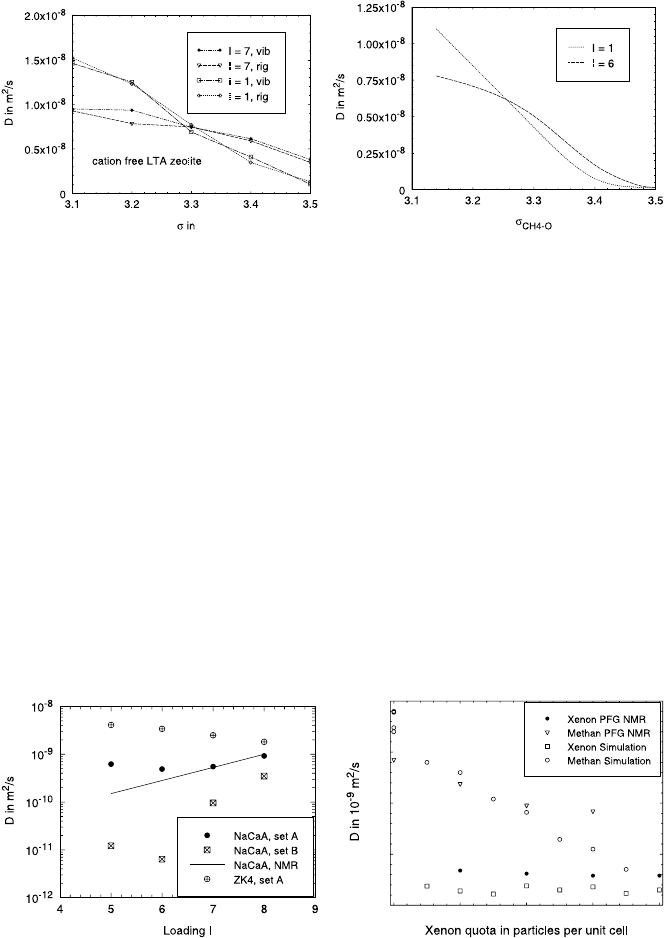
934 Reinhold Haberlandt
Å
Fig. 23.12. Comparison of D with rigid and vibrating lattice (left: set A; right:
set B)
Influence of Cations on D
The dynamics of even small neutral molecules with saturated bindings is
strongly influenced by the presence of exchangeable cations [44, 46]. This is
investigated for the NaCaA zeolite with 4 Na
+
and 4 Ca
++
ions. In this case
the windows – marked by w in Fig. 23.5 (right) – are (as in the case of the
cation-free LTA) free from cations. The unexpected (see [20]) strong effect can
clearly be seen in Fig. 23.13 (left) and has been confirmed experimentally,
meanwhile ([105], see Chap. 10). In comparison with the cation-free LTA,
the self-diffusivity decreases by up to two orders of magnitude. It should
be noted that the computational effort is much larger in this case than in
the simulations for the cation-free form since much longer trajectories (up
to 5-10 ns) are necessary to evaluate such small diffusivities. Additionally,
the calculation of the forces resulting from the polarization energy is very
024 68
2.0
1.5
1.0
0.5
0
Fig. 23.13. Calculated diffusion coefficients compared with NMR data (left: D of
methane in NaCaA and cation-free LTA; right: mixture of CH
4
/Xe in silicalite at
a total loading of 8 guest molecules per unit cell. The ratio of Xe/CH
4
content is
varied keeping the sum of concentrations constant.)

23 Statistical Theory and Molecular Dynamics of Diffusion in Zeolites 935
time-consuming although the full Ewald sum can be replaced by a corrected
r space part of this sum.
Comparison between MD Simulations and Experimental NMR
Data
Fig. 23.13 (left) shows MD results for different situations. Comparison with
experimental results from NMR measurements [106] yields satisfactory agree-
ment in the case of set A.
Fig. 23.13 (right) shows that the agreement between numerical MD values
and measured NMR data is sufficient also in the case of methane and xenon
mixtures (for more details, see [107,108]).
Propagators and Related Functions
So-called propagators P (r,t|r
0
, 0 ) (see p. 928 and (23.22)) represent an-
other way to describe diffusion processes.
Experimentally accessible is the averaged propagator
P (r,t)=
p (r
0
) P (r
0
+ r,t|r
0
, 0) dr
0
, (23.25)
where p (r
0
) denotes the probability density of finding a molecule at posi-
tion r
0
. The averaged propagator represents the probability distribution of
molecular displacements r during the time interval t for an arbitrarily se-
lected molecule within the sample under study. The pulsed field gradient
(PFG NMR) technique [82] allows the determination of the averaged prop-
agator [83, 84] over time and space scales of typically milliseconds and mi-
crometers. As an example, Fig. 10.1 of Chap. 10 displays the propagation
patterns of ethane in beds of zeolite NaCaA with two different crystallite
sizes for different temperatures [83].
In statistical physics and quasielastic neutron scattering (QENS) – with
the relevant time and space scales of 1...100 ps and nanometers –, the averaged
propagator P (r,t) is generally referred to as the self-part G
s
(r,t)oftheVan
Hove autocorrelation function G(r,t) [40,54–58]
G(r,t)=
1
N
=
N
j=1
N
=1
δ[r + r
(0) − r
j
(t)]
>
, (23.26)
with N denoting the particle number. This is seen to be the probability
density of finding some particle at time t at distance r from the position of
aparticleattimet
0
= 0. For distinguishable particles one can split G(r,t)
into the self-part G
s
and the distinct-part G
d
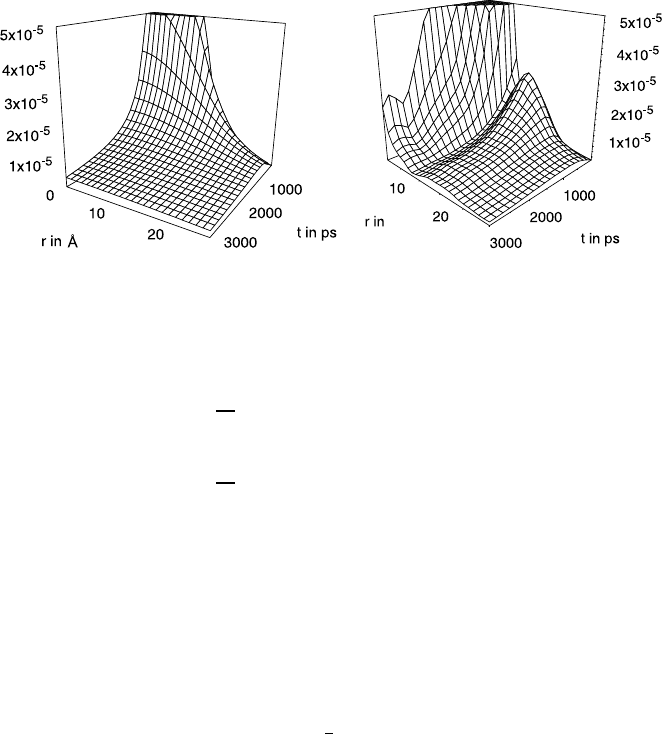
936 Reinhold Haberlandt
Å
Fig. 23.14. Propagator P (r,t) as function of r and t; left: in ideal bulk systems;
right: in ‘ZK4’ (set B, I =3,T = 300 K).
G(r,t)=G
s
(r,t)+G
d
(r,t), (23.27)
G
s
(r,t)=
1
N
=
N
j=1
δ[r + r
j
(0) − r
j
(t)]
>
, (23.28)
G
d
(r,t)=
1
N
=
N
j=1
N
=1(=j)
δ[r + r
(0) − r
j
(t)]
>
. (23.29)
The self-part G
s
correlates positions of the same particle (j = ) at different
times while G
d
correlates positions of different ones (j = ). G
s
(r,t)givesthe
probability density that within time t a particle moves by r, while G
d
(r,t)
gives the probability density of finding a particle at time t at a distance r
from the position of another particle at time 0.
In a homogeneous system, the propagator P (r,t) (cf. (23.25)) is easily
found to have a Gaussian form
P (r,t)=(4πDt)
−
3
2
exp
−r
2
/ (4Dt)
, (23.30)
with D denoting the self-diffusivity.
The evolution of the probability of particle displacements as contained in
the spatial-temporal dependence of the propagator, corresponding to (23.30),
is shown in Fig. 23.14 (left). Fig. 23.14 (right) illustrates that the heterogene-
ity of the host system leads to a fine-structure of the propagator – with spac-
ings given by the separation between adjacent pore centres. The propagator
in Fig. 23.14 (right) has been determined by MD simulations for methane in a
cation-free A-type zeolite (ZK4) for potential set B (see Table 23.2), loading
I = 3 and temperature T = 300 K [54, 55].
Fig. 23.15 shows – in another representation – the same behaviour for the
Van Hove function G
s
(x, t), Gaussian in the free space (above) and structured
for methane in ZK4 at I =3andT = 300 K (below). The specific structur-
ization of the propagators (see Figs. 23.14 (right) and 23.19) is caused by the

23 Statistical Theory and Molecular Dynamics of Diffusion in Zeolites 937
x in Å
t in ps
Gxt(,)
s
t in ps
x in Å
Gxt(,)
s
Fig. 23.15. Self-part G
s
(x, t) of the Van Hove correlation function in the bulk
(above) and the diffusion of methane in ZK4 at I =3andT = 300 K (below).
reflections of the guest molecules at the walls of the cavities in the zeolites
which yield peaks in the correlation functions. For an ideal zeolite lattice, the
periodicity of the propagator is conserved over arbitrarily large space and
time scales. This is demonstrated by Fig. 23.15.
Figure 23.16 shows the dynamic structure factor S(k,ω)(k – wave vector,
ω – frequency), i. e. the double Fourier transform of the propagator (self-part
of the Van Hove function)
S(k,ω)=
1
2π
∞
−∞
P (r,t)e
−i(k·r−ωt)
dr dt (23.31)
as the quantity directly accessible by QENS [52, 53] (see Chaps. 2 and 3).
S(k,ω) is a generalization of the static case in which the differential cross
section is expressed in terms of the pair distribution function (see (23.7d)).
Fig. 23.17 shows the intermediate scattering function F (k,t)ofQENS,
whichisdefinedby
F (k,t)=
P (r,t) e
−i kr
d r ,G
s
(r,t) ≡ P (r,t) (23.32)

938 Reinhold Haberlandt
k in Å
in ps
Sk(, )
s
-1
-1
Fig. 23.16. Self-part S
s
(k, ω) of the dynamic structure factor for methane in ZK4
at I =3andT = 300 K.
k in Å
t in ps
Fkt(,)
s
-1
Fig. 23.17. Self-part F
s
(k, t) of the scattering function for methane in ZK4 at
I =3andT = 300 K.
using the propagator of methane in cation-free zeolite LTA [54,55]. The scat-
tering vector k has been chosen to be parallel to one of the crystallographic
axes.
For zeolites of non-cubic structure, the propagator exhibits the differ-
ences of molecular propagation in different directions. This is exemplified by
Fig. 23.18 showing the propagator with respect to the x-, y-andz-axes for
methane in silicalite.
The over-all self-diffusion coefficient D evaluated from the corresponding
scattering factor S(k,ω)is8.6 ·10
−9
m
2
s
−1
, which is in good agreement with
the experimental value of 9.3 · 10
−9
m
2
s
−1
extrapolated from QENS data
measured by Jobic et al. [52]. Analytical approximations for G
s
(r,t)andthe
related quantities are given in [54,55]. The experimental observation of such
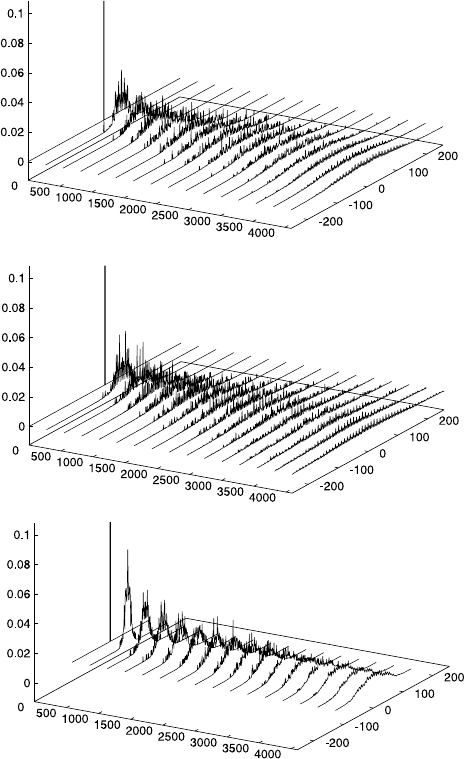
23 Statistical Theory and Molecular Dynamics of Diffusion in Zeolites 939
y in Å
t in ps
Gxt(,)
s
t in ps
x in Å
Gyt(,)
s
z in Å
t in ps
Gzt(,)
s
Fig. 23.18. Self-part G
s
of the Van Hove correlation function for the diffusion of
methane in silicalite in x-, y-, and z-direction at I =3andT = 300 K.
structured propagators is a challenging task for QENS. In the light of the
theory, such a behaviour should quite generally be expected.
Fig. 23.19 uses an alternative representation of the propagator for vi-
sualizing the diffusion behaviour of C
2
H
6
in ZK4 in a time interval of
t =1....1000 ps [57,61]. In this case, the propagator was calculated with re-
spect to two coordinates x, y. It can be seen that the propagator shows a more
complicated structure than in the case of CH
4
, most likely as a consequence
of the more intricate intermolecular interaction.
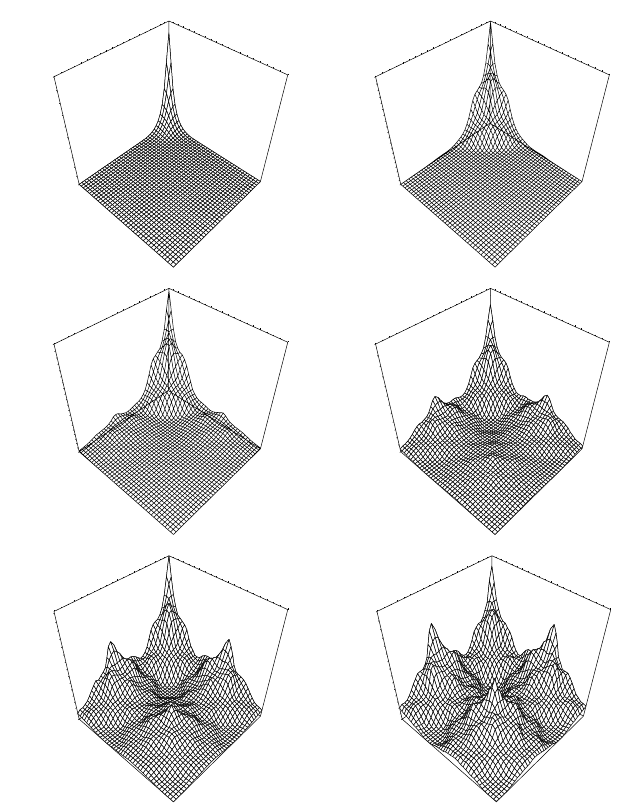
940 Reinhold Haberlandt
5
10
15
20
x
5
10
15
20
y
0
0.02
0.04
0.06
0.08
0.10
P(x,y,t)
t=1 ps
5
10
15
20
x
5
10
15
20
y
0
0.005
0.010
0.015
0.020
P(x,y,t)
t=10 ps
5
10
15
20
x
5
10
15
20
y
0
0.003
0.006
0.009
0.012
P(x,y,t)
t=100 ps
5
10
15
20
x
5
10
15
20
y
0
0.002
0.004
0.006
P(x,y,t)
t=300 ps
5
10
15
20
x
5
10
15
20
y
0
0.001
0.002
0.003
P(x,y,t)
t=500 ps
5
10
15
20
x
5
10
15
20
y
0
0.0005
0.0010
0.0015
P(x,y,t)
t=1000 ps
Fig. 23.19. Two-dimensional graph of the time development of the propagator
P (x, y, t)(x, y in
˚
A; t in ps) calculated from a trajectory (potential set A, see
Table 23.2, I =3,T = 300 K, D =2· 10
−9
m
2
s
−1
) [61].

23 Statistical Theory and Molecular Dynamics of Diffusion in Zeolites 941
Transport-Diffusivity, Corrected Diffusivity and Self-Diffusivity
While the self-diffusion coefficient D according to the Kubo theory may be
obtained from [2, 6, 17, 27, 48]
D =
1
3N
N
j=1
∞
0
dtv
j
(0)v
j
(t), (23.33a)
the so-called corrected diffusion coefficient D
c
includes the cross-correlations
between velocities of different particles
D
c
=
1
3N
N
j=1
N
k=1
∞
0
dtv
j
(0)v
k
(t). (23.33b)
The diffusion coefficient that appears in Fick’s law is often called transport
diffusion coefficient D
T
[14]
J = −D
T
d n
dx
, (23.33c)
J is the flux and n is the density. If the force F in the well-known relation
v = BF , (23.33d)
is substituted by the chemical potential µ one has
J = −nB
d µ
dx
, (23.33e)
where B is the mobility. According to Kubo’s theory B is connected with the
corrected diffusivity by the relation
D
c
= Bk
B
T. (23.33f)
Comparison of (23.33c) and (23.33e) together with (23.33f) leads to
D
T
= D
c
n
k
B
T
dµ
dn
, (23.33g)
which is a somewhat unusual form of the well-known Darken equation and has
been used already in Sect. 4.4 of Chap. 10 (cf. (10.23)) [14]. These different
diffusivities obtained from equilibrium and non-equilibrium MD simulations
are compared with each other (Fig. 23.20 (right)). The self-diffusion coeffi-
cients have been obtained from the mean square displacement. D
T
results
from non-equilibrium simulations in which a density gradient (see Fig. 23.20
(left)) in six layers of cavities is created by randomly inserting particles that
leave the last layer and enter into the first layer. The flux has been evaluated
in the intermediate region only [48]. D
xy
s
is obtained from the mean square
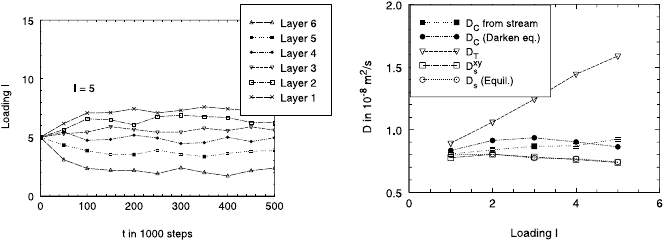
942 Reinhold Haberlandt
Fig. 23.20. Transport diffusion coefficients (left: Concentration gradient versus
time; right: Transport diffusion coefficient D
T
from non-equilibrium MD) in com-
parison to self-diffusion coefficient D and corrected diffusion coefficient D
c
.
displacement perpendicular to the density gradient. It turns out that the flux
has practically no influence on the self-diffusion in the direction perpendic-
ular to the flux. D
c
is somewhat larger than D, which might be attributed
to the collective effects expressed by the cross-correlation terms in (23.33b).
D
c
is obtained from D
T
by the Darken equation and compared with results
from another non-equilibrium MD experiment. In this experiment, a flux is
produced by an external field. Measuring this flux, D
c
may be obtained from
(23.33f).
23.5 Conclusion
Diffusion coefficients of guest molecules in zeolites have been calculated under
different conditions:
1. Statistical physics and molecular dynamics provide the basis for the eval-
uation of diffusion coefficients of guest molecules in zeolites and for the
comparison to experimental data.
2. Summarizing this chapter one can state:
a) Even single particles diffusing through narrow cavities in zeolites show
a macroscopic behaviour, which obeys the diffusion equation for not
too small times and distances.
b) Temperature dependencies of diffusion coefficients of guest molecules
show very often an Arrhenius behaviour.
c) Small changes in lattice parameters can cause dramatic changes in
the diffusion coefficient, even in the dependence on concentration.
d) The presence of cations Na
+
,Ca
++
strongly influences the diffusion
of even neutral molecules [46], while the assumption of a fixed lattice
seems to significantly affect the diffusion coefficients only in excep-
tional cases. Thus, as a rule, a fixed lattice can be used.
23 Statistical Theory and Molecular Dynamics of Diffusion in Zeolites 943
e) MD calculations for single- and two-component adsorbates are in fair
agreement with measured NMR and QENS data [22,53, 108].
f) Non-equilibrium simulations show that transport-diffusion includes
additional contributions in comparison with self-diffusion.
g) In order to get reliable data in evaluating the diffusion coefficients
one needs good statistics, i. e. long runs with short time steps (up to
millions of steps of 5-10 fs each) and a large number of MD boxes
(here used up to 343).
h) Hierarchical simulations lead to an extension of the possible time
scale of the examined processes by orders of magnitude.
3. More information, especially about the analytical treatment of the diffu-
sion of guest molecules in zeolites (using for instance the Maxwell–Stefan
formulation (MS method) [26,85,86]), transition state theory (TST), dy-
namically corrected transition state theory (DCTST), lattice gas theories
and dynamical Monte Carlo simulations, respectively), can be found in
the literature [22, 90–104].
4. More and more the potentials used will be determined by different meth-
ods such as fitting procedures (i. e. comparison with experimental data)
and more sophisticated methods in determining intermolecular potentials
(i. e. quantum mechanical calculations and, later on, density functional
methods) [27,28, 67].
5. For the future, one can look forward to solving more complex and realistic
problems including diffusion and/or reaction – up to catalysis – of non-
reactive [107,108] and reactive mixtures of guest molecules. An overview
of a lot of recent examinations in the field of diffusion and also some
simple models of chemical reactions and catalysis can be found in [22,23,
67, 109–123].
Notation
A
Γ
, A
τ
ensemble, time average
D, D
s
(self-) diffusion coefficient
D
c
,D
T
corrected, transport diffusivity
F
i
force components
F (k,t) scattering function
f(ω) Fourier transform of
v(0) · v(t)
G(r, t) Van Hove auto correlation function
g(r) radial distribution function
H(q
i
,p
i
,t) Hamiltonian function
˙
J
i
(t)
˙
J
j
(0)
Γ
transport coefficient
J
i
,X
z
flux densities, generalized forces
K
AB
(t) time correlation function A(t)B(0)
Γ
k
B
Boltzmann constant
